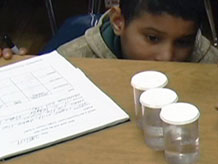What causes the water level to rise?
2. Explore water displacement


Return to the investigation question:
What causes the water level to rise?
Explicitly point out that we are trying to determine if volume or weight is the cause.
Distribute a tray of materials to each group. Ask students to examine the two cubes to see how they compare. Do they agree that they have the same volume? Can they tell that the copper cube is much heavier than the aluminum cube?
Point out the plastic modeling clay and the scale. Let students know they can cut and form the plastic modeling clay into a third cube having the same weight as the aluminum cube.
Ask students to help you list the steps for a fair test that will answer the investigation question. An example is given below.
Steps for a Fair Test:
- Equalize the starting water levels and mark them on the containers.
- Weigh the 2 cubes.
- Compare the volumes of the 2 cubes.
- Carefully place the cubes in the containers of water.
- Compare the water levels in the containers.
- Compare the water levels of the two cubes that have the same weight (i.e., the aluminum cube and the plastic modeling clay cube).
Have students open their science notebooks and record their predictions, then set the groups to work. Students should first compare the aluminum and copper cubes and then work on comparing the aluminum and plastic modeling clay cubes.
As you circulate among the groups, confirm that the volume of the plastic modeling clay cube is greater than the volume of the aluminum cube. Make sure students are recording their predictions and their data in their notebooks [How much will the water level rise?].
Let students know that the only quantitative data they will record is the weight of the cubes (in grams); the volume data and the water levels will be comparative data, e.g., " volume is greater than the other." or "the water rose higher."



